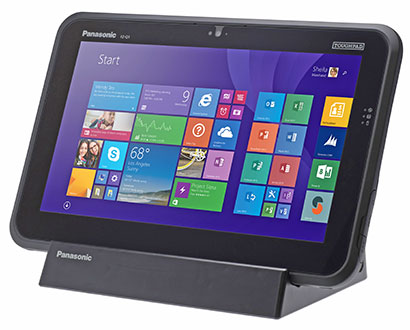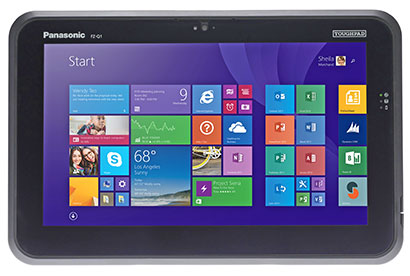On January 5, 2016, Panasonic introduced the Windows-based 12.5-inch Toughpad FZ-Q1 as the newest member of its Toughpad family of enterprise-grade rugged tablet computers. The new Toughpad also joins the trend towards offering "pro" versions that differentiate themselves with larger displays and extra features. Examples are the iPad Pro, the Microsoft Surface Pro 4, and the Xplore Motion R12.

Right upfront, let's state where this new Toughpad is supposed to fit in. It's larger and heavier than Microsoft's slender, fragile 12.3-inch Surface Pro 4. But it's lighter and, despite being a Toughpad, not quite as rugged as Xplore's 12.5-inch Motion R12. Jan Ruderman, VP of Panasonic's Business Mobility Group, explains that "many applications don't require a fully rugged device, and as a result, businesses felt compelled to purchase consumer-grade solutions. Unfortunately, those tablets don't provide the reliability, usability and security businesses require and consumer device manufacturers typically don't have the sales and services infrastructure needed to support enterprise customers."
That means the FZ-Q1 is a Toughpad with a shock-absorbing case and one of those magnesium alloy chassis Panasonic pioneered and is famous for, but this is a Toughbook that's as tough as it needs to be, and not as tough as it can possibly be. That makes it "semi-rugged," and that's reflected in pricing that's much lower than fully rugged gear. There are two versions of the FZ-Q1, standard and professional. The standard version starts at US$999 and the professional one at US$1,699. That's a significant price difference so let's see how the two versions differ.
The standard model comes with a dual-core Intel Celeron N2807 chip, 4GB of RAM, and 64GB of eMMC storage. The professional model with a dual-core, quad-thread Intel Core i5-4302Y, 8GB of RAM, and 128GB of SSD storage. The much more complex chip in the professional version alone costs US$180 more, there's twice as much RAM, and also twice as much mass storage, and in the professional version it's of the speedy SSD instead of the slower eMMC kind. So the extra money buys a very considerably more powerful tablet.

Apart from that, the two versions are largely the same. There's the large and reasonably bright 350 nit 12.5-inch display with full 1920 x 1080 pixel HD resolution, anti-glare treatment, preinstalled replaceable screen film, and 10-finger capacitive multi-touch. There's a capacitive stylus that we hope is of the same superior technology as the one Panasonic uses in the Toughpad FZ-M1. There's Bluetooth 4.0, speedy 802.11ac WiFi, optional 4G LTE multi-carrier mobile broadband with satellite GPS, USB 3.0 and a micro SDXC card slot. Optionally available are either a slot-based or contactless Smart Card reader. The 34 watt-hour Li-Ion battery is said to last up to 9 hours.
Onboard wired I/O is limited, as it is in most tablets. There a USB 3.0 port, an audio jack and the power plug, and that's about it. For wireless there's Bluetooth 4.0, fast 802.11ac WiFi, and customers can also specify optional 4G LTE mobile broadband. The tablet has a 2-megapixel webcam in th front, and a 8-megapixel documentation camera in the rear. Since it's mandatory for many governmental and enterprise deployments, Panasonic also offers the FZ-Q1 with either standard or contactless Smart Card readers.
|
Toughpad Q1 CPUs (see full specs)
|
Intel Core
(FZ-Q1 Performance Model)
|
Intel Celeron
(FZ-Q1 Standard Model)
|
|
Model
|
i5-4302Y
|
N2807
|
|
Code Name
|
Haswell
|
Bay Trail
|
|
Lithography
|
22nm
|
22nm
|
|
Cores/Threads
|
2/4
|
2/2
|
|
Base Clock Speed
|
1.60 GHz
|
1.58 GHz
|
|
Turbo Speed
|
2.30 GHz (turbo)
|
2.16 GHz (burst)
|
|
Thermal Design Power (TDP)
|
11.5 watts
|
4.3 watts
|
|
Scenario Design Power (TDP)
|
4.5 watts
|
2.5 watts
|
|
Smart Cache
|
3MB
|
1MB
|
|
Instruction set
|
64-bit
|
64-bit
|
|
Integrated graphics
|
HD Graphics 4200
|
HD Graphics
|
|
Graphics base speed
|
200 MHz
|
313 MHz
|
|
Graphics max speed
|
850 MHz
|
750 MHz
|
|
USB 3.0
|
Yes
|
Yes
|
|
Intel vPro
|
Yes
|
No
|
|
Intel Anti Theft
|
Yes
|
No
|
The table to the right shows a comparison between the processors in the standard and performance version of the Toughpad FZ-Q1. One is a true Core processor whereas the other is part of Intel's "Bay Trail" lineup that's based on the much simpler Atom architecture. Both have Intel HD Graphics but the version in the Core I5 chip is more advanced and has more execution units. The i5 chip also includes a variety of Intel technologies that may or may not important in a given application. What this means is that purchase decisions should not be made on price alone.
But what about ruggedness? While almost all Panasonic Toughbook and Toughpad products sport a distinctly rugged black and silver-metallic design language, the FZ-Q1 is all black and looks more like a standard contemporary consumer tablet. It's a fanless design thanks to its super-efficient processors and carries an IP5x rating, which means it's resistant to dirt and dust, but there's no rating for no protection against liquids (the FZ-Q1 does have port covers, though). The specs also do not include an operating temperature range, but do list an optional solid state drive heater. Thanks to the magnesium alloy chassis, ABS casing and elastomer edge guards Panasonic says it can withstand drops and provides "the ideal level of durability for light duty field work." Given Panasonic's track record in rugged notebooks and tablets we have no doubt it can, but do hope we'll get to see more detailed ruggedness specs in addition to just the "MIL-STD-810G design" designation.
So what's the bottom line for this latest Panasonic Toughpad? The FZ-Q1 addresses the emerging demand for larger-screen tablets, and it does so in a cleanly designed, versatile package that's reasonably priced. We also like the availability of two distinctly different performance levels, and the thought Panasonic put into creating a product that's tough enough for use away from the office, but that's not weighed down by the price and weight of a fully rugged design.



